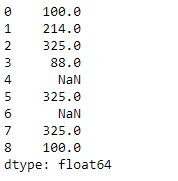Python是進行數據分析的一種出色語言,主要是因為以數據為中心的python軟件包具有奇妙的生態係統。 Pandas是其中的一種,使導入和分析數據更加容易。
Pandas 係列是帶有軸標簽的一維ndarray。標簽不必是唯一的,但必須是可哈希的類型。該對象同時支持基於整數和基於標簽的索引,並提供了許多方法來執行涉及索引的操作。
Pandas Series.value_counts()函數返回一個包含唯一值計數的Series。結果對象將按降序排列,因此第一個元素是最frequently-occurring元素。默認情況下不包括NA值。
用法: Series.value_counts(normalize=False, sort=True, ascending=False, bins=None, dropna=True)
參數:
normalize:如果為True,則返回的對象將包含唯一值的相對頻率。
sort:按值排序。
ascending:升序排列。
bins:而不是對值進行計數,而是將它們分組到half-open箱中,這是pd.cut的一種便利,僅適用於數字數據。
dropna:不包括NaN計數。
返回:數量:係列
範例1:采用Series.value_counts()函數以查找給定Series對象中每個元素的唯一值計數。
# importing pandas as pd
import pandas as pd
# Creating the Series
sr = pd.Series(['New York', 'Chicago', 'Toronto', 'Lisbon', 'Rio', 'Chicago', 'Lisbon'])
# Print the series
print(sr)輸出:

現在我們將使用Series.value_counts()函數以查找給定Series對象中每個唯一值的值計數。
# find the value counts
sr.value_counts()輸出:

正如我們在輸出中看到的,Series.value_counts()函數已返回給定Series對象中每個唯一值的值計數。
範例2:采用Series.value_counts()函數以查找給定Series對象中每個元素的唯一值計數。
# importing pandas as pd
import pandas as pd
# Creating the Series
sr = pd.Series([100, 214, 325, 88, None, 325, None, 325, 100])
# Print the series
print(sr)輸出:

現在我們將使用Series.value_counts()函數以查找給定Series對象中每個唯一值的值計數。
# find the value counts
sr.value_counts()輸出:

正如我們在輸出中看到的,Series.value_counts()函數已返回給定Series對象中每個唯一值的值計數。
相關用法
- Python pandas.map()用法及代碼示例
- Python Pandas Series.str.len()用法及代碼示例
- Python Pandas.factorize()用法及代碼示例
- Python Pandas TimedeltaIndex.name用法及代碼示例
- Python Pandas dataframe.ne()用法及代碼示例
- Python Pandas Series.between()用法及代碼示例
- Python Pandas DataFrame.where()用法及代碼示例
- Python Pandas Series.add()用法及代碼示例
- Python Pandas.pivot_table()用法及代碼示例
- Python Pandas Series.mod()用法及代碼示例
- Python Pandas Dataframe.at[ ]用法及代碼示例
- Python Pandas Dataframe.iat[ ]用法及代碼示例
- Python Pandas.pivot()用法及代碼示例
- Python Pandas dataframe.mul()用法及代碼示例
- Python Pandas.melt()用法及代碼示例
注:本文由純淨天空篩選整理自Shubham__Ranjan大神的英文原創作品 Python | Pandas Series.value_counts()。非經特殊聲明,原始代碼版權歸原作者所有,本譯文未經允許或授權,請勿轉載或複製。
